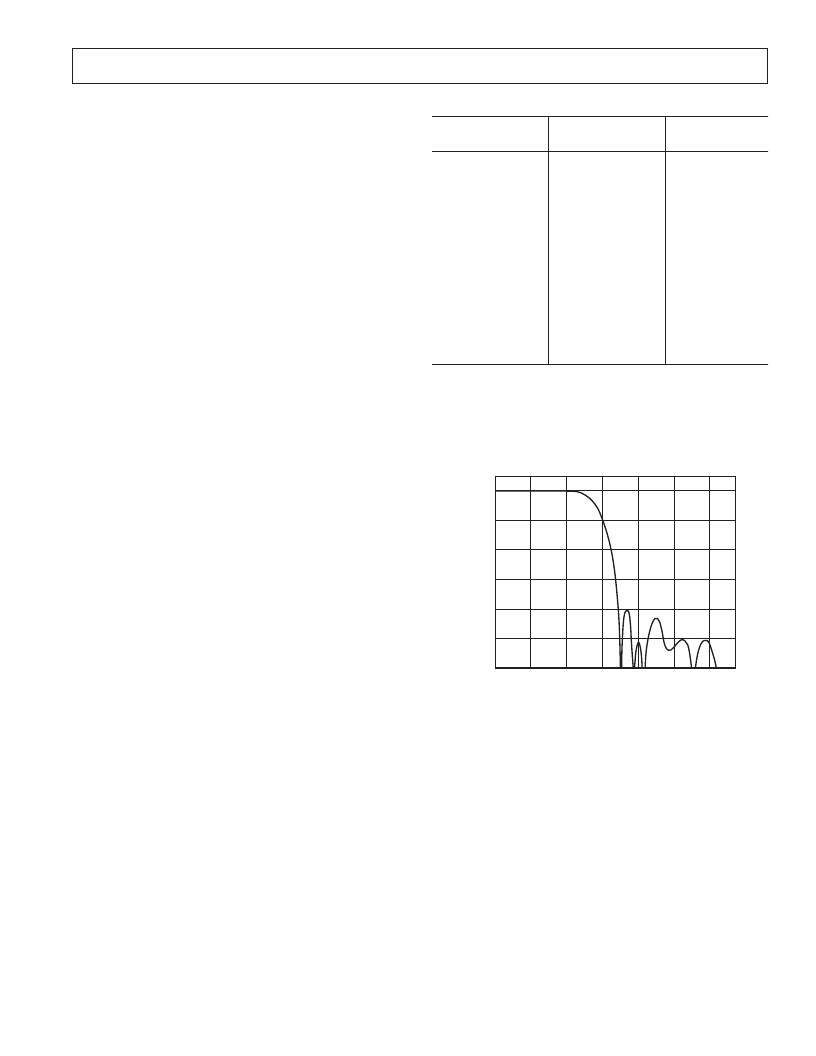- 您現(xiàn)在的位置:買賣IC網(wǎng) > PDF目錄378286 > ADV7330 (Analog Devices, Inc.) Multiformat 11-Bit Triple DAC Video Encoder PDF資料下載
參數(shù)資料
| 型號: | ADV7330 |
| 廠商: | Analog Devices, Inc. |
| 英文描述: | Multiformat 11-Bit Triple DAC Video Encoder |
| 中文描述: | 多格式11位DAC的視頻編碼器三 |
| 文件頁數(shù): | 35/76頁 |
| 文件大小: | 1378K |
| 代理商: | ADV7330 |
第1頁第2頁第3頁第4頁第5頁第6頁第7頁第8頁第9頁第10頁第11頁第12頁第13頁第14頁第15頁第16頁第17頁第18頁第19頁第20頁第21頁第22頁第23頁第24頁第25頁第26頁第27頁第28頁第29頁第30頁第31頁第32頁第33頁第34頁當(dāng)前第35頁第36頁第37頁第38頁第39頁第40頁第41頁第42頁第43頁第44頁第45頁第46頁第47頁第48頁第49頁第50頁第51頁第52頁第53頁第54頁第55頁第56頁第57頁第58頁第59頁第60頁第61頁第62頁第63頁第64頁第65頁第66頁第67頁第68頁第69頁第70頁第71頁第72頁第73頁第74頁第75頁第76頁

REV. B
ADV7330
–35–
Table VI. Internal Filter Specifications
Pass-Band Ripple 3 dB Bandwidth
(dB)
1
Filter
(MHz)
2
Luma LPF NTSC
Luma LPF PAL
Luma Notch NTSC
Luma Notch PAL
Luma SSAF
Luma CIF
Luma QCIF
Chroma 0.65 MHz
Chroma 1.0 MHz
Chroma 1.3 MHz
Chroma 2.0 MHz
Chroma 3.0 MHz
Chroma CIF
Chroma QCIF
0.16
0.1
0.09
0.1
0.04
0.127
Monotonic
Monotonic
Monotonic
0.09
0.048
Monotonic
Monotonic
Monotonic
4.24
4.81
2.3/4.9/6.6
3.1/5.6/6.4
6.45
3.02
1.5
0.65
1
1.395
2.2
3.2
0.65
0.5
NOTES
1
Pass-band ripple refers to the maximum fluctuations from the 0 dB response in
the pass band, measured in (dB). The pass band is defined to have 0 (Hz) to
fc (Hz) frequency limits for a low-pass filter, 0 (Hz) to f1 (Hz) and f2 (Hz) to
infinity for a notch filter, where fc, f1, f2 are the –3 dB points.
2
3 dB bandwidth refers to the –3 dB cutoff frequency.
FREQUENCY (MHz)
0
G
–10
–30
–50
–60
–20
–40
6
5
4
3
2
1
0
EXTENDED UV FILTER MODE
Figure 29. UV SSAF Filter
SD Internal Filter Response
[Subaddress 40h; Subaddress 42, Bit 0]
The Y filter supports several different frequency responses includ-
ing two low-pass responses, two notch responses, an extended
(SSAF) response with or without gain boost/attenuation, a CIF
response, and a QCIF response. The UV filter supports several
different frequency responses including six low-pass responses,
a CIF response, and a QCIF response, as can be seen in the
typical performance characteristics graphs on the following pages.
If SD SSAF gain is enabled, there is the option of 12 responses in
the range of –4 dB to +4 dB [Subaddress 47, Bit 4]. The desired
response can be chosen by the user by programming the correct
value via the I
C [Subaddress 62h]. The variation of frequency
responses can be seen in the typical performance characteristics
graphs on the following pages.
In addition to the chroma filters listed in Table VI, the ADV7330
contains an SSAF filter specifically designed for and applicable
to the color difference component outputs, U and V.
This filter has a cutoff frequency of about 2.7 MHz and –40 dB
at 3.8 MHz, as can be seen in Figure 29. This filter can be
controlled with Address 42h, Bit 0.
If this filter is disabled, the selectable chroma filters shown in
Table VI can be used for the CVBS or chroma signal.
相關(guān)PDF資料 |
PDF描述 |
|---|---|
| ADV7330KST | Multiformat 11-Bit Triple DAC Video Encoder |
| ADXL321 | Small and Thin 18 g Accelerometer |
| ADXL321EB | Small and Thin 18 g Accelerometer |
| ADXL321JCP | Small and Thin 18 g Accelerometer |
| ADXL321JCP-REEL | Small and Thin 18 g Accelerometer |
相關(guān)代理商/技術(shù)參數(shù) |
參數(shù)描述 |
|---|---|
| ADV73305502 | 制造商:LG Corporation 功能描述:FRAME ASSEMBLY |
| ADV73306701 | 制造商:LG Corporation 功能描述:Frame Assembly |
| ADV73306702 | 制造商:LG Corporation 功能描述:Frame Assembly |
| ADV73306703 | 制造商:LG Corporation 功能描述:Frame Assembly |
| ADV73306704 | 制造商:LG Corporation 功能描述:Frame Assembly |
發(fā)布緊急采購,3分鐘左右您將得到回復(fù)。